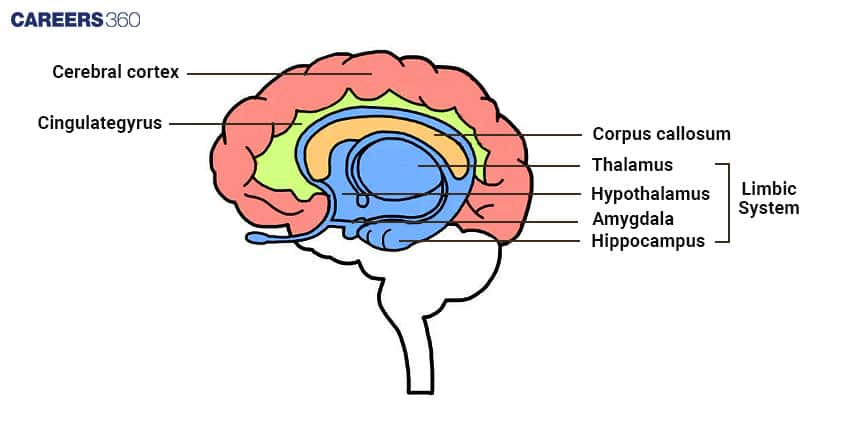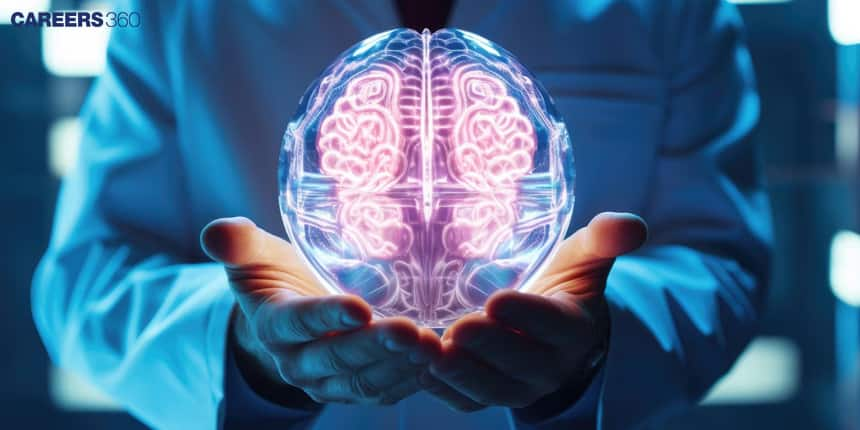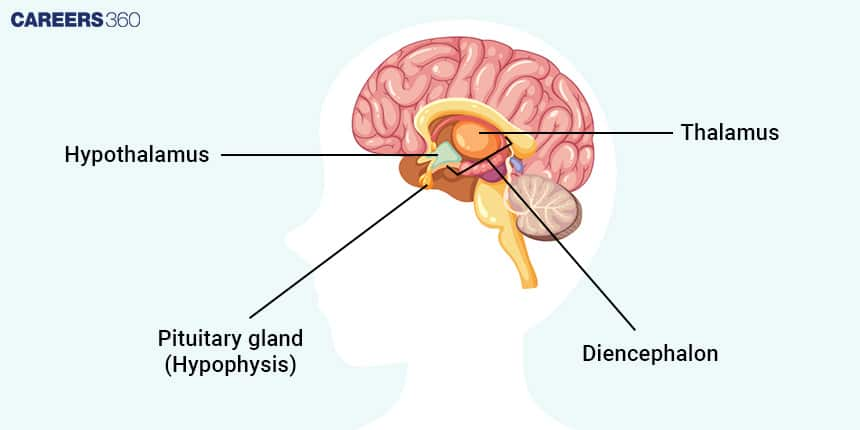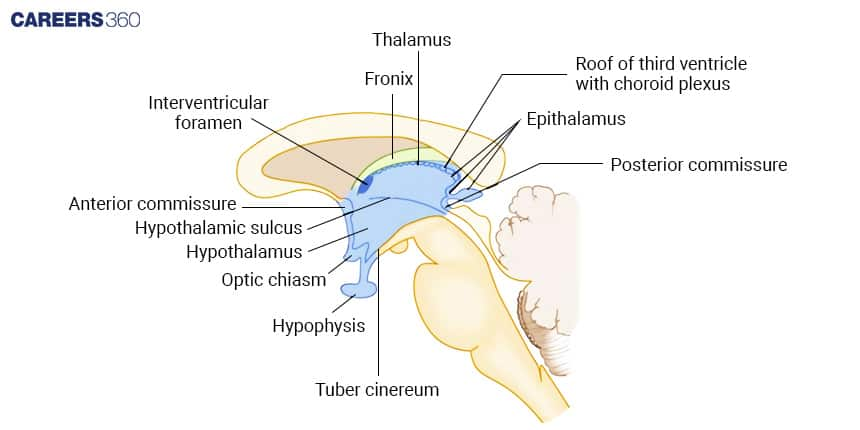1. What are the constituents that make up the forebrain?
Cerebrum, thalamus, and hypothalamus are present.
2. What is the function of the thalamus?
The thalamus relays sensory and motor signals to the cerebral cortex and participates in regulating consciousness, sleep, and alertness.
3. How does the hypothalamus achieve homeostasis?
Controls body temperature, hunger, thirst, and circadian rhythm; it controls the secretion of hormones.
4. What are basal ganglia associated with?
Basal ganglia have been associated with voluntary motor movements, procedural learning, routine behaviours, and coordination of movement and posture.
5. What are the effects of damage to the forebrain?
Therefore, damage to the forebrain can result in serious impairment of cognition and sensation—especially in thinking and planning, including sensory processing.
6. How do the basal ganglia contribute to motor control?
The basal ganglia are a group of subcortical nuclei in the forebrain that play a crucial role in motor control. They help initiate and coordinate voluntary movements, suppress unwanted movements, and contribute to motor learning. Disorders affecting the basal ganglia, like Parkinson's disease, can lead to movement problems.
7. What is the function of the basal forebrain, and how does it relate to attention?
The basal forebrain is a region that includes several structures like the nucleus basalis. It plays a crucial role in attention, arousal, and learning. The basal forebrain produces acetylcholine, a neurotransmitter important for cognitive functions. Damage to this area can lead to attention deficits and memory problems.
8. What is the function of the striatum in the forebrain?
The striatum, part of the basal ganglia, plays a crucial role in motor control, action selection, and reward-based learning. It receives input from the cerebral cortex and helps coordinate voluntary movement. The striatum is also involved in habit formation and is affected in movement disorders like Parkinson's disease and Huntington's disease.
9. How does the forebrain contribute to reward and motivation?
The forebrain contains key structures of the brain's reward system, including the nucleus accumbens and parts of the prefrontal cortex. These areas respond to pleasurable stimuli and play a role in motivation, reinforcement learning, and addictive behaviors. Dopamine, a neurotransmitter produced in the midbrain, acts on these forebrain structures to signal reward and drive motivation.
10. What is neuroplasticity, and how does it relate to the forebrain?
Neuroplasticity refers to the brain's ability to change and reorganize itself throughout life. The forebrain, especially the cerebral cortex, exhibits high neuroplasticity. This allows for learning, memory formation, and recovery from brain injuries. The forebrain's plasticity is crucial for adapting to new experiences and environments.
11. What are the main divisions of the forebrain?
The forebrain has two main divisions: the telencephalon and the diencephalon. The telencephalon includes the cerebral cortex, basal ganglia, and limbic system. The diencephalon contains structures like the thalamus and hypothalamus. These divisions work together to process sensory information, control motor functions, and regulate various bodily processes.
12. What is the limbic system, and how does it relate to emotions?
The limbic system is a group of interconnected structures in the forebrain, including the amygdala, hippocampus, and parts of the thalamus and hypothalamus. It plays a crucial role in emotional processing, memory formation, and motivation. The amygdala, for instance, is particularly important for fear and aggression responses.
13. How does the corpus callosum facilitate communication between brain hemispheres?
The corpus callosum is a large bundle of nerve fibers that connects the left and right cerebral hemispheres. It allows for communication and information transfer between the two sides of the brain, enabling coordinated processing and integration of information. This is crucial for complex tasks that require both hemispheres to work together.
14. How does the prefrontal cortex contribute to decision-making and personality?
The prefrontal cortex, located in the frontal lobe of the cerebral cortex, is crucial for executive functions like decision-making, planning, and impulse control. It's also involved in personality expression and social behavior. Damage to this area can lead to changes in personality, difficulty in planning, and impaired judgment.
15. How does the forebrain process sensory information?
The forebrain processes sensory information through specialized areas in the cerebral cortex. For example, visual information is processed in the occipital lobe, auditory information in the temporal lobe, and touch in the parietal lobe. The thalamus acts as a relay station, directing sensory inputs to the appropriate cortical areas for higher-level processing.
16. What is the difference between gray matter and white matter in the forebrain?
Gray matter primarily consists of neuronal cell bodies, dendrites, and unmyelinated axons. It's found in the outer layer of the cerebral cortex and in subcortical nuclei. White matter, on the other hand, consists mainly of myelinated axons that connect different brain regions. The myelin gives it a white appearance and allows for faster signal transmission.
17. What is the role of the insula in the forebrain?
The insula, or insular cortex, is a region of the cerebral cortex folded deep within the lateral sulcus. It plays a role in consciousness, emotion, and regulation of homeostasis. The insula is involved in processing feelings from the body, such as pain, temperature, and visceral sensations, and contributes to emotional experiences and self-awareness.
18. What is the function of the olfactory bulb in the forebrain?
The olfactory bulb is part of the forebrain responsible for processing smell. It receives input directly from olfactory receptors in the nose and is one of the few areas where new neurons are continuously generated throughout life. The olfactory bulb processes and relays smell information to other brain areas for further interpretation and memory formation.
19. How does the forebrain contribute to spatial navigation?
Spatial navigation involves several forebrain structures. The hippocampus is crucial for forming cognitive maps of the environment. The entorhinal cortex contains grid cells that help with position tracking. The prefrontal cortex is involved in planning routes, while the parietal cortex helps integrate spatial information. These structures work together to enable complex navigation abilities.
20. What is the role of the cingulate cortex in the forebrain?
The cingulate cortex is part of the limbic system and plays roles in emotion formation, learning, and memory. It's also involved in executive function, particularly in error detection, conflict monitoring, and decision-making. The anterior cingulate cortex is especially important for cognitive control and has been implicated in processes like empathy and pain perception.
21. What is the forebrain and why is it considered the most complex part of the brain?
The forebrain is the largest and most anterior part of the brain. It's considered the most complex because it's responsible for higher-order functions like thinking, reasoning, and emotional processing. It contains structures like the cerebral cortex, which is highly developed in humans and allows for advanced cognitive abilities.
22. How does the cerebral cortex contribute to the forebrain's functions?
The cerebral cortex, part of the telencephalon, is crucial for higher-order cognitive functions. It's divided into lobes (frontal, parietal, temporal, and occipital), each specializing in different functions like reasoning, sensory processing, memory, and vision. The cortex's folded structure increases its surface area, allowing for more neural connections and complex processing capabilities.
23. What role does the thalamus play in the forebrain?
The thalamus, located in the diencephalon, acts as a relay station for sensory and motor signals. It receives information from various sensory organs and sends it to the appropriate areas of the cerebral cortex for processing. It also plays a role in regulating consciousness, sleep, and alertness.
24. How does the hypothalamus contribute to homeostasis?
The hypothalamus, another diencephalon structure, is crucial for maintaining homeostasis. It regulates body temperature, hunger, thirst, sleep-wake cycles, and hormone production by the pituitary gland. By monitoring internal and external conditions and initiating appropriate responses, the hypothalamus helps keep the body in balance.
25. How does the forebrain differ from other parts of the brain in terms of evolution?
The forebrain is the most recently evolved part of the brain. While lower brain regions like the hindbrain and midbrain are similar across many vertebrates, the forebrain, especially the cerebral cortex, is much more developed in mammals and reaches its peak complexity in humans. This evolutionary expansion allows for more sophisticated cognitive abilities.
26. What is the role of the hippocampus in memory formation?
The hippocampus, part of the limbic system, plays a vital role in forming new memories and spatial navigation. It's particularly important for converting short-term memories into long-term memories. Damage to the hippocampus can result in anterograde amnesia, where a person struggles to form new memories.
27. How does the forebrain contribute to language processing?
Language processing primarily occurs in the forebrain, specifically in areas like Broca's area (involved in speech production) and Wernicke's area (involved in language comprehension). These areas, usually located in the left hemisphere, work together with other brain regions to enable complex language abilities, including speaking, understanding, reading, and writing.
28. How does the forebrain regulate the sleep-wake cycle?
The forebrain, particularly the hypothalamus, plays a crucial role in regulating the sleep-wake cycle. The suprachiasmatic nucleus in the hypothalamus acts as the body's "biological clock," responding to light signals and coordinating circadian rhythms. Other forebrain structures, like the basal forebrain, also contribute to sleep regulation and arousal.
29. What is the role of the amygdala in emotional processing?
The amygdala, part of the limbic system in the forebrain, is crucial for processing emotions, particularly fear and aggression. It helps evaluate the emotional significance of stimuli and contributes to emotional learning and memory. The amygdala is also involved in the fight-or-flight response, triggering physiological reactions to perceived threats.
30. How does the forebrain process pain?
Pain processing in the forebrain involves multiple areas. The somatosensory cortex processes the sensory aspects of pain, while areas like the insula and anterior cingulate cortex process the emotional aspects. The prefrontal cortex is involved in cognitive evaluation of pain. This distributed processing allows for the complex, multidimensional experience of pain.
31. How does the forebrain contribute to memory consolidation during sleep?
During sleep, the forebrain, particularly the hippocampus and neocortex, is involved in memory consolidation. The hippocampus replays recent experiences, strengthening synaptic connections. This information is gradually transferred to the neocortex for long-term storage. This process, known as systems consolidation, helps stabilize and integrate new memories into existing knowledge networks.
32. What is the role of the fornix in the forebrain?
The fornix is a C-shaped bundle of nerve fibers in the forebrain that connects the hippocampus to other brain regions, including the mammillary bodies and the anterior thalamic nuclei. It plays a crucial role in memory processing by facilitating the transfer of information between these structures. Damage to the fornix can result in memory impairments.
33. How does the forebrain contribute to social cognition?
Social cognition involves several forebrain structures. The prefrontal cortex is crucial for understanding others' mental states (theory of mind) and social decision-making. The amygdala helps process emotional expressions and social cues. The superior temporal sulcus is involved in perceiving biological motion and social attention. These areas work together to enable complex social interactions.
34. What is the function of the claustrum in the forebrain?
The claustrum is a thin, irregular sheet of neurons in the forebrain. While its exact function is still debated, it's thought to play a role in consciousness and the integration of information from different sensory modalities. It has extensive connections with the cortex and may be involved in focusing attention and coordinating brain activity.
35. How does the forebrain regulate appetite and food intake?
The forebrain, particularly the hypothalamus, plays a key role in regulating appetite and food intake. The arcuate nucleus in the hypothalamus contains neurons that respond to hormones like leptin and ghrelin, signaling hunger or satiety. Other forebrain areas, like the insula and orbitofrontal cortex, are involved in food-related decision-making and the pleasure associated with eating.
36. What is the role of the septum in the forebrain?
The septum is a forebrain structure that's part of the limbic system. It's involved in reward and reinforcement, particularly in relation to addictive behaviors. The septum also plays a role in emotional processing, memory, and motivation. It has connections with the hippocampus and is thought to be involved in regulating hippocampal activity.
37. How does the forebrain contribute to executive functions?
Executive functions, which include skills like planning, decision-making, and impulse control, primarily rely on the prefrontal cortex in the forebrain. Different regions of the prefrontal cortex contribute to various aspects of executive function. For example, the dorsolateral prefrontal cortex is involved in working memory and cognitive flexibility, while the ventromedial prefrontal cortex is crucial for decision-making and emotional regulation.
38. What is the function of the nucleus accumbens in the forebrain?
The nucleus accumbens, part of the ventral striatum, plays a central role in the brain's reward system. It's involved in processing rewarding stimuli, motivation, and reinforcement learning. The nucleus accumbens receives dopaminergic input from the midbrain and is crucial for the experience of pleasure and the development of addictive behaviors.
39. How does the forebrain process visual information?
Visual processing in the forebrain primarily occurs in the occipital lobe, specifically in the primary visual cortex (V1) and surrounding visual association areas. Information from the retina is relayed through the thalamus to V1, where basic features like edges and orientations are processed. Higher-order visual areas then process more complex features like motion, color, and object recognition.
40. What is the role of the forebrain in emotional regulation?
Emotional regulation involves several forebrain structures. The prefrontal cortex, particularly the ventromedial and orbitofrontal regions, is crucial for cognitive control of emotions. The amygdala processes emotional stimuli and generates emotional responses. The anterior cingulate cortex is involved in emotional awareness and regulation. These areas interact to allow for complex emotional experiences and control.
41. How does the forebrain contribute to attention and focus?
Attention involves a network of forebrain structures. The prefrontal cortex is crucial for sustained attention and ignoring distractions. The parietal cortex helps direct attention in space. The anterior cingulate cortex is involved in conflict monitoring and shifting attention. The thalamus acts as a gateway, filtering which sensory information reaches consciousness. These areas work together to allow for focused attention on relevant stimuli.
42. What is the function of the habenula in the forebrain?
The habenula is a small structure in the epithalamus, part of the diencephalon. It plays a role in reward processing, particularly in learning from negative experiences. The habenula is activated by aversive stimuli and helps suppress dopamine release, contributing to behaviors like avoidance learning. It's also involved in regulating sleep-wake cycles and mood.
43. How does the forebrain process auditory information?
Auditory processing in the forebrain primarily occurs in the temporal lobe. Sound information from the ear is relayed through the thalamus to the primary auditory cortex, where basic features like pitch and volume are processed. Surrounding auditory association areas then process more complex features like speech sounds and music. The left hemisphere is typically dominant for language-related auditory processing.
44. What is the role of the forebrain in decision-making under uncertainty?
Decision-making under uncertainty involves several forebrain structures. The prefrontal cortex, particularly the orbitofrontal cortex, is crucial for evaluating potential outcomes and risks. The anterior cingulate cortex helps detect conflicts and errors in decision-making. The insula is involved in risk assessment and the emotional aspects of decision-making. These areas work together to allow for complex decision-making in uncertain situations.
45. How does the forebrain contribute to time perception?
Time perception involves multiple forebrain areas. The prefrontal cortex and basal ganglia are important for timing in the seconds-to-minutes range. The hippocampus is involved in temporal sequencing and memory for events. The insula may contribute to the subjective experience of time passing. These areas work together to allow for the complex perception and estimation of time intervals.
46. What is the function of the bed nucleus of the stria terminalis (BNST) in the forebrain?
The BNST is part of the extended amygdala and plays a role in the stress response and anxiety. It's involved in processing threatening stimuli, particularly those that are prolonged or unpredictable. The BNST also contributes to the regulation of the hypothalamic-pituitary-adrenal (HPA) axis, which is crucial for the body's stress response.
47. How does the forebrain contribute to language comprehension?
Language comprehension primarily involves the left hemisphere of the forebrain. Wernicke's area,




